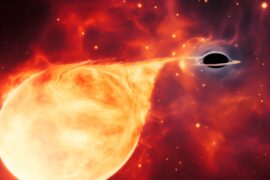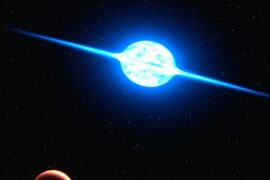Out of the 88 constellations, there are two shaped like a triangle. These are the Triangulum constellation and Triangulum Australe. There are also two other famous asterisms or formations with the same shape. They are very aptly named the Summer Triangle and the Winter triangle.
Asterisms like the Summer and Winter triangles are kind of like unofficial constellations. They are commonly recognized groups of stars that most people can recognize but are not technically considered a constellation. Other examples of asterisms would be the Big dipper and the Northern cross.
Triangle constellations are very interesting because when you think about it, any group of 3 stars that are close in the sky form a triangle. So why did only these receive the name? Was it simply that they didn’t fit into any other close constellation? or is there something special about them?
Let’s take a look at each to find out.
The Triangulum Constellation

A grand majority of the constellations we know today come from the second century when the Greek astronomer Ptolemy created a catalog with 48 constellations. Because of his location, these constellations only included the ones he could see in Europe and with the naked eye as the telescope wouldn’t be invented for another 1,400 years.
This is important because it tells us a lot about why Triangulum was named as such.
It turns out that the three stars in the constellation not only are very close to each other and form almost a perfect isosceles triangle, but they also have very similar brightness.
Now that we have a measure for the brightness of a star called “apparent magnitude”, we can tell that the stars that form Triangulum have a magnitude between 3 and 4. This likelihood is what makes them look like they belong together so much.
The stars that make up the Triangulum are:
- Alpha Trianguli
- Beta Trianguli
- Gamma Trianguli
- Triangulum had many different names thoughout Greek history. At some point it was called Deltoton because they thought it looked like the Greek letter Delta, later it was called Sicilia because it had a similar shape to the (now Italian) island of Sicily. But at all points it kep its triangular shape.
Triangulum is located in the NQ1 quadrant, which means it is slightly easier to see in the Northern hemisphere. It is easier to see in the month of December when it can be found directly overhead at around 9:00 PM of your local time.
It borders with the constellation of Andromeda, Aries, Perseus, and Pisces.
If you point a mid-range telescope at Triangulum, you will also be able to see the Triangulum Galaxy, which is located more than 2.7 million light-years away from Earth.
Triangulum Australe
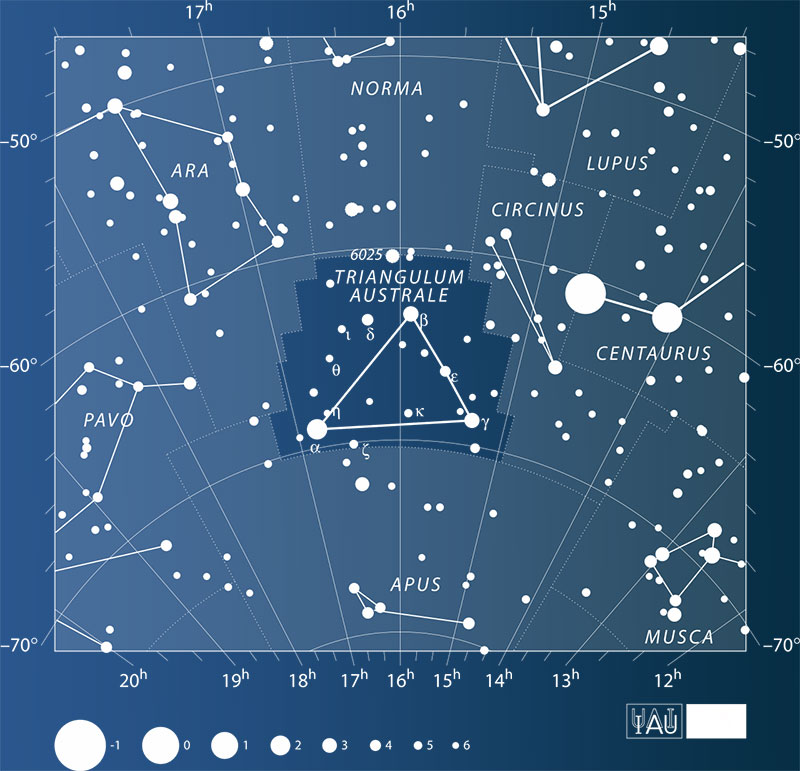
Fun fact: In Latin, the word Australis means “south”.
With that information, you can guess that the name of the constellation Triangulum Australe, means “southern triangle“.
It was named like that because it can only be seen in the southern hemisphere and some places near the equator so you will not be able to see it if you live in the US or Europe.
Because of this, Triangulum Australe wasn’t one of the 48 constellations in Ptolemy’s catalog, instead, it was until the modern catalog of 88 constellations was created that it was recognized as such.
The triangle the stars in this constellation form is almost exactly equilateral, which means it has 3 equal sides.
The stars that make up the constellation are:
- Atria (also known as Alpha Trianguli Australis)
- Beta Trianguli Australis
- Gamma Trianguli Australis
Atria is one of the 50 brightest stars in the sky, so it is the most prominent and easy to recognize of the three.
Triangulum Australe borders with the constellations of Norma, Ara, Cirus, and Apus.
Just like Triangulum, Triangulum Australe also contains a few deep sky objects within its area, the most prominent of which is the star cluster NGC 6025, located at “only” 2,700 light-years away from Earth.
The Summer Triangle
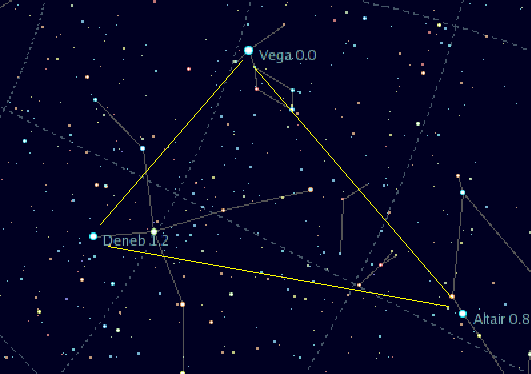
The Summer Triangle is an asterism, not a constellation. Still, it is one of the most recognizable and well-known formations of stars in the sky.
The summer triangle is made out of 3 of the brightest stars in the night sky, and that is why it is so easy to recognize and why people started to consider it an asterism.
These stars are:
- Deneb (also known as Alpha Cygni)
- Altair (also known as Alpha Aquilae)
- Vega (also known as Alpha Lyrae)
Each of these stars belongs to a different constellation, those are Cygnus, Aquila and Lyra respectively. These constellations border each other which is why Deneb, Altair, and Vega are relatively close to each other.
The name of the summer triangle was given to it because, during the summer months, it is located overhead around midnight. During these months, it can also be seen for most of the night.
The asterism can also be seen during spring and fall, but only at certain hours.
The term has been used by astronomers at least since the 1920s when it was referred to as “the great triangle”, later it was also known as “the summerly triangle” until the British astronomer Patrick Moore finally popularized the name “summer triangle” in the 1950s.
All of the three stars in the summer triangle have an apparent magnitude below 1.25, which means they are very bright stars that can be seen with the naked eye, even in big cities despite the high levels of light pollution.
The Winter Triangle
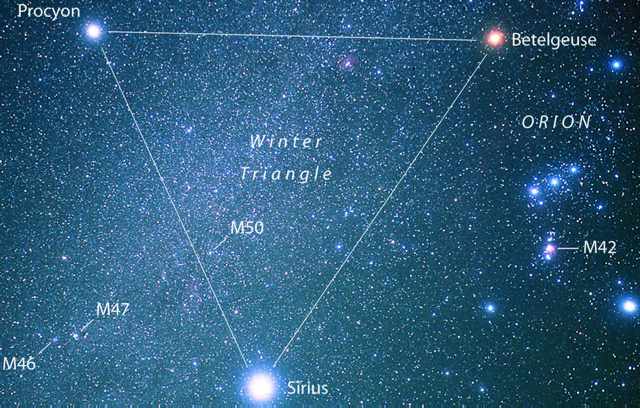
Just like its summer counterpart, the Winter Triangle is an asterism made by 3 of the brightest stars that can be seen during the Winter Months.
The winter triangle is formed by the following stars:
- Sirius (Alpha Canis Majoris)
- Betelgeuse (Alpha Orionis)
- Procyon (Alpha Canis Minoris)
The stars belong to the constellations of Canis Major, Orion, and Canis Minor respectively.
If you noticed, the scientific designations for the stars, just like the ones in the summer triangle, start with the alpha greek letter. This means that the star is the brightest one in its constellation.
The stars in the winter triangle have an apparent magnitude below 0.5. This means they are all brighter than the stars in the summer triangle (a lower magnitude means a brighter star). In fact, Sirius is the brightest star in the night sky with an apparent magnitude of -1.46
You can see the Winter Triangle during the Winter months almost all night long, but it is easier to find around midnight when it is directly overhead. It can also be seen in the Fall and Spring at limited times.
Thanks to how bright the stars in the asterism are, you should have no problem observing it even under bad light pollution conditions.
Summary
- There are two constellations shaped like a triangle: Triangulum and Triangulum Australe
- There are two popular asterisms that form equilateral triangles, these are the Summer Triangle and the Winter Triangle, but they are not official constellations
- Triangulum can be seen in the Northern hemisphere, Triangulum Australe in the Southern hemisphere
- The Wummer and Winter triangles can be better seen during the seasons that give them their respective names.
Enjoyed this article?
Get daily 10-minute PDFs about astronomy to read before bed!
Sign up for our upcoming micro-learning service where you will learn something new about space and beyond every day while winding down.





